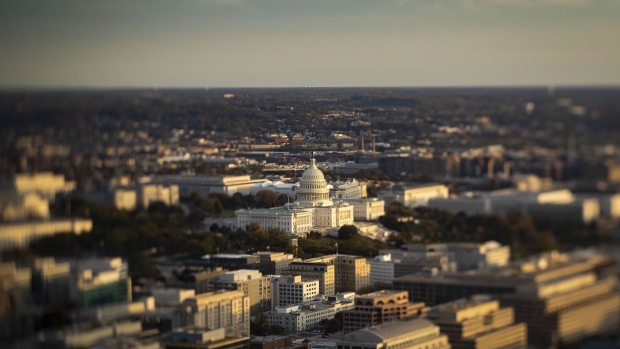Oct 21, 2022
US Budget Gap Plunges to $1.38 Trillion as Pandemic Aid Unwinds
, Bloomberg News

(Bloomberg) -- The US budget deficit fell by a record in the 2022 financial year, a second straight drop that reflects the drying up of Covid-related aid spending alongside a surge in revenues propelled by wage and employment gains.
The deficit for the fiscal year through September narrowed to $1.38 trillion, from a revised $2.78 trillion the previous year, according to US Treasury Department data released Friday.
The headline gap between the government’s spending and revenue figures are a perennial hot-button issue in Congress, often wielded as a key metric as Democrats and Republican push competing agendas.
Focus on the deficit is set to continue in the coming year with a number of costs and a fight over the debt ceiling looming, as well as inflation running near a 40-year high -- blamed partly on government spending during the pandemic. Rising interest rates mean the Treasury will need to pay out more in debt-servicing costs, while emergency spending for Hurricane Ian also looms.
Still, Treasury Secretary Janet Yellen said Friday, “I do see our debt as being on a responsible path.” Answering questions from reporters, she said, “It is important to have a credible fiscal policy and to make sure the debt is sustainable over time, and our budgets have done that.”
Student Debt
The 2022 deficit reduction came even after accounting for President Joe Biden’s move to forgive a swath of student loans. The department said loan modifications had a $430 billion impact on the month of September, a sharp increase from the $137 billion recognition of such costs in September 2021. The Treasury said that it didn’t anticipate further such large-scale hits to the budget from the loan-forgiveness move in subsequent months.
Republicans have blasted the American Rescue Plan for fueling the fastest inflation in 40 years, and criticized the student-debt forgiveness as another measure that will add to price pressures.
Stripping out fiscal years 2021 and 2020, when spending surged during the pandemic, the most recent figures show the biggest deficit since 2009, in the wake of the global financial crisis.
As a share of gross domestic product, the deficit came in at 5.5%. The ratio hit a record 15% in 2020 on pandemic relief spending. Before the crisis, in 2019, the deficit was 4.7% of GDP. That had widened by a percentage point from 2017, the year before tax cuts under President Donald Trump took effect.
Stripping out fiscal years 2021 and 2020, when spending surged during the pandemic, the most recent figures show the biggest deficit as a percentage of GDP since 2012.
“Today we have further proof that we are rebuilding the economy in a responsible way,” Biden said Friday after the figures were released. “We’re going from historically strong economic recovery, to a steady and stable growth while reducing the deficit.”
--With assistance from Jordan Fabian.
(Updates with comparisons with previous years from eighth paragraph.)
©2022 Bloomberg L.P.